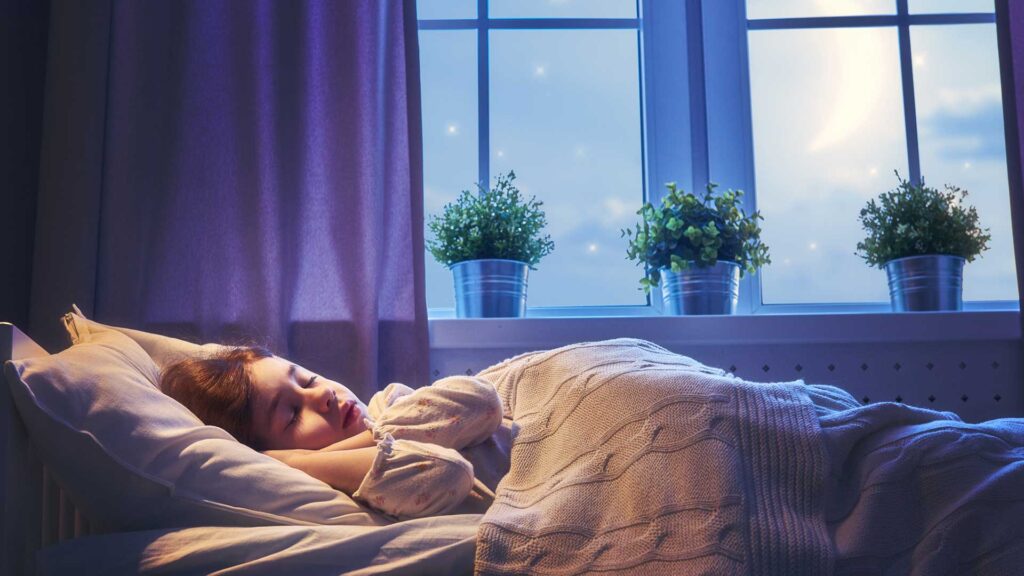
TikTok is never short of sleep hacks, but one new marvel is gaining steam as an effective and evidence-based way to help you relax and drift off with ease — moon breathing. This breathwork practice is not just a new trend but an ancient yogic technique known as moon-piercing breath or chandra bhedana. Advocates say this breath practice shifts you into a peaceful and relaxed state, ideal for winding down before heading to dreamland or helping you slip back to sleep if you wake during the night.
If you are one of the 30 percent of adults who experience chronic insomnia, you’ll likely try anything to ease it, and breathwork is a tried and true relaxation tool that works for many people. Since consistently losing sleep can have pretty substantial adverse effects on your health and wellbeing, it’s worth learning more about moon breathing and how it might help.
What is Moon Breathing and How it’s Different
Moon breathing, or Chandra Bhedana Pranayama, is a yogic breathing technique with roots in ancient yoga traditions. It’s named after the moon (Chandra in Sanskrit), symbolizing coolness and calmness. “This practice is designed to activate the Ida Nadi, which is associated with the moon’s cooling energy and is believed to have a calming and soothing effect on the body and mind,” explains Aine Rock, a breathwork facilitator, Reiki Master, Yoga Instructor, and Integrative Life Coach based in California.
Also known as Left Nostril Breathing, moon breathing involves blocking the right nostril, forcefully inhaling through the left nostril, holding the breath, then blocking the left nostril and exhaling through the right, explains Nakita Devi, a Breathwork Practitioner, triple board accredited with the International Breathwork Foundation, the Global Professional Breathwork Alliance, and the American Association of Drugless Practitioners. “You can also sustain the breath after the exhale before repeating this cycle for as long as desired,” she says.
Here are some expert tips for how to perform moon breathing:
- Find a Comfortable Position: Sit comfortably in a meditative posture such as Padmasana (Lotus Pose) or Sukhasana (Easy Pose). You may also adopt a mudra with the hands and/or tongue, e.g., Khechari and Vishnu mudras.
- Prepare for the Practice: Close your eyes and take a few deep, natural breaths to center yourself. Relax your whole body. Exhale and empty your lungs when you are ready to begin.
- Block the Right Nostril: Gently close your right nostril using your right thumb, keeping the other fingers extended/in mudra.
- Inhale through the Left Nostril: Slowly and deeply inhale through your left nostril, filling your lungs with air. Close the left nostril using the right ring finger, and hold the breath.
- Close the Left Nostril and Exhale through the Right: Use your ring finger to close the left nostril. When ready, release the right nostril and exhale slowly and completely. Advanced practitioners can also practice with Kumbhaka (Breath retention) here.
- Repeat: This completes one round. Continue the practice from step 4 for several rounds, maintaining slow, deep, and rhythmic breaths.
Unlike regular breathing, which typically involves both nostrils, moon breathing specifically involves inhaling through the left nostril and exhaling through the right. This intentional change in breathing is thought to activate specific energy channels and create a calming effect on the nervous system and body.
Chandra Bhedana is also distinct from other breathing techniques in its specific focus on the lunar or cooling aspect of breath; through inhaling exclusively through the left nostril. “In comparison, other pranayama have different effects on the body, for example, Kapalabhati for energy and clarity, or Ujjayi for building focus and concentration,” explains Devi.
Benefits of Moon Breathing
There are several benefits of trying moon breathing for yourself, such as better sleep and overall wellbeing. By promoting relaxation, moon breathing can help alleviate anxiety, enhance mental clarity and calmness, and may help in balancing the body’s energy and emotions, according to Rock. Here are some of the ways moon breathing can support healthy sleep:
Calms the Nervous System
Moon breathing is thought to work by activating the parasympathetic nervous system, creating a calming effect, and reducing stress and anxiety, according to Rock. The practice also promotes balanced breathing, which can improve focus and relaxation. Breathwork practices encouraging relaxation and relieving stress, such as moon breathing, can indirectly stimulate the release of calming neurotransmitters like acetylcholine that help you feel ready to slumber.
Slows Heart Rate
Although you can’t control your heart rate directly, you can influence it through breath control. In fact, your diaphragm is unique since it’s a muscle and organ that works involuntarily but also one you can control. Moon breathing, in particular, has been shown to slow the heart rate and blood pressure, which is key for drifting off to sleep.
Supports the Vagus Nerve
Researchers believe moon breathing likely works by altering the vagus nerve, a prime player in promoting sleep and restfulness (1). Deep breathing and breathwork practices such as moon breathing can support emotional regulation by activating the vagus nerve, which helps improve emotional stability and manage stress. Stress and high emotions get in the way of proper sleep, whether by keeping you up with racing thoughts or preventing your body from entering a calm state for rest (2).
Other forms of breathwork for sleep include box breathing and the 4-7-8 technique. Breathwork is often part of other relaxation practices that facilitate sleep, such as meditation and yoga, each with plenty of scientific evidence to back them up.
Tips for Beginners
Chandra Bhedana, like any pranayama or breathwork practice, can offer numerous benefits when done correctly. However, beginners need to approach it with mindfulness and follow any safety precautions. Here are some tips and considerations provided by Devi:
Start Slow and Build Your Practice: Begin with a few minutes of Chandra Bhedana and gradually extend the duration as you become more comfortable. Avoid pushing yourself too hard, especially in the beginning.
Sit Comfortably: Sit in a comfortable and stable seated posture with a straight spine. If sitting on the floor is uncomfortable, use a chair with your feet flat. Sit so that the body is alert yet relaxed.
Nasal Patency: Ensure that your nasal passages are not congested. If you have a cold or any nasal blockages, consider postponing the practice until your nostrils are clear, or use other breath techniques to clear these passages first.
Keep the Breath Gentle and Relaxed: Keep the breath easy, gentle, and smooth. Relax the facial muscles and avoid unnecessary jaw, forehead, and neck tension. This helps in maintaining a calm and centered state.
Build Consistency: Like any yoga, somatic, or breath practice, consistency is key. Regular but gradual practice will yield more significant and sustainable benefits over time.
Who Should Avoid Moon Breathing
“Generally, moon breathing is safe for most people; however, individuals with certain conditions should exercise caution,” says Rock, citing heart issues or high blood pressure, respiratory conditions such as asthma, or pregnancy as reasons to avoid moon breathing until you have the all-clear from your doctor.
If you experience any discomfort, strain, or dizziness while performing moon breath or any breathwork technique, discontinue the practice. Pranayama should not cause any pain or excessive discomfort. “Allow the breath to return to its natural rhythm; you can resume Chandra Bhedana when you feel ready,” says Devi.
It’s best to consult with a healthcare professional before embracing any new breathing technique, especially if you have any underlying health conditions.
Sources
Rock, Aine. Author interview. November 2024.
Devi, Nakita. Author interview. November 2024.
1. Bhavanani AB, Madanmohan, Sanjay Z. Immediate effect of chandra nadi pranayama (left unilateral forced nostril breathing) on cardiovascular parameters in hypertensive patients. Int J Yoga. 2012 Jul;5(2):108-11. doi: 10.4103/0973-6131.98221. PMID: 22869993; PMCID: PMC3410188.
2. Mariam Kashani, Arn Eliasson & Marina Vernalis (2012) Perceived stress correlates with disturbed sleep: A link connecting stress and cardiovascular disease, Stress, 15:1, 45-51, DOI: 10.3109/10253890.2011.578266




























